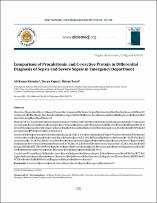| dc.contributor.author | Erenler, Ali Kemal | |
| dc.contributor.author | Yapar, Derya | |
| dc.contributor.author | Terzi, Özlem | |
| dc.date.accessioned | 2019-06-14T12:05:06Z | |
| dc.date.available | 2019-06-14T12:05:06Z | |
| dc.date.issued | 2017 | en_US |
| dc.identifier.citation | Erenler, A. K., Yapar, D., Terzi, Ö. (2017). Comparison of procalcitonin and c-reactive protein in differential diagnosis of sepsis and severe sepsis in emergency department. Dicle Tıp Dergisi, 44(2), 175-182. | en_US |
| dc.identifier.issn | 1300-2945 | |
| dc.identifier.uri | http://dx.doi.org/10.5798/dicletip.319750 | |
| dc.identifier.uri | https://hdl.handle.net/11491/3359 | |
| dc.description | research | en_US |
| dc.description.abstract | Objective: Sepsis and severe sepsis (sepsis accompanied by acute organ dysfunction) are leading causes of death worldwide. In this study, our aim was to investigate utility of biomarkers commonly used in diagnosis of sepsis in discriminating these two entities. Methods: Two-hundred and three patients involved were divided into 2 subgroups as sepsis and severe sepsis according to Surviving Sepsis Campaign: International Guidelines for Management of Severe Sepsis and Septic Shock: 2012. Then groups were compared according to clinical and laboratory (including C-reactive protein (CRP) and procalcitonin (PCT) levels) characteristics. Results: Of 203 patients included into the study, 124 (61.1%) were male and 79 (38.9%) were female. The most common reason for sepsis was urinary tract infection (n=64, 31.5%), followed by catheter infection (n=16, 7.9%) and pneumonia (n=14, 6.9%). Escherichia coli was the most common agent in both blood and urinary cultures. Majority of the patients were treated with ceftriaxone (n=33, 16.3%), followed by meronem/dapson (n=25, 12.3%). In both groups, CRP and PCT levels were high, even higher in severe sepsis group. However, any statistical significance could not be determined between groups. Mortality rate in sepsis patients was 6.4%. Conclusion: Plasma levels of both markers elevate in sepsis and severe sepsis. It was determined that CRP and PCT is higher in severe sepsis than in sepsis. However, the difference is not statistically significant. Plasma levels of CRP and PCT are not useful in differential diagnosis of sepsis and severe sepsis | en_US |
| dc.description.abstract | Amaç: Sepsis ve şiddetli sepsis (akut organ disfonksiyonunun eşlik ettiği sepsis) dünyada ölümlerin başlıca nedenlerindendir. Bu çalışmada amacımız, sepsis tanısında sıkça kullanılan biyobelirteçlerin bu iki durumun ayrımındaki yararlılıklarını araştırmaktır. Yöntemler: Dahil edilen 203 hasta; Surviving Sepsis Campaign: International Guidelines for Management of Severe Sepsis and Septic Shock: 2012 kılavuzuna göre sepsis ve şiddetli sepsis olmak üzere iki gruba ayrılmıştır. Daha sonra gruplar klinik ve laboratuar (C-reaktif protein (CRP) ve prokalsitonin (PCT) dahil olmak üzere) özelliklerine göre karşılaştırılmıştır. Bulgular: Çalışmaya katılan 203 hastanın 124 (%61,1)'ü erkek, 79 (%38,9)'u kadındı. Sepsisin en sık nedeni üriner sistem enfeksiyonlarını (n=64, %31,5) takiben kateter enfeksiyonları (n=16, %7,9) ve pnömoni (n=14, %6,9) idi. Üriner ve kan kültürlerinde en sık ajan Escherichia coli olarak tespit edildi. Hastaların çoğu seftriakson (n=33, %16,3) ile tedavi edilirken bunu meronem/dapson (n=25, %12,3) tedavisi takip etti. Her iki grupta da CRP ve PCT düzeyleri yüksek iken şiddetli sepsis grubunda daha yüksek saptandı. Ne var ki, gruplar arasında istatistiksel olarak anlamlı fark tespit edilemedi. Sepsis hastalarında mortalite oranı %64 olarak saptandı. Sonuç: Sepsis ve şiddetli sepsiste her iki beirtecin de plazma düzeyleri artmaktadır. Şiddetli sepsiste CRP ve PCT seviyelerinin sepsise kıyasla daha yüksek olduğu tespit edildi. Ne var ki, aradaki fark istatistiksel olarak anlamlı değildi. Sepsis ve şiddetli sepsisin ayırıcı tanısında CRP ve PCT'nin plazma düzeyleri faydalı bulunmamıştır | en_US |
| dc.language.iso | eng | en_US |
| dc.publisher | Dicle Üniversitesi Tıp Fakültesi | en_US |
| dc.relation.isversionof | 10.5798/dicletip.319750 | en_US |
| dc.rights | info:eu-repo/semantics/openAccess | en_US |
| dc.subject | C-Reactive Protein | en_US |
| dc.subject | Procalcitonin | en_US |
| dc.subject | Sepsis | en_US |
| dc.subject | Severe Sepsis | en_US |
| dc.subject | Emergency Department | en_US |
| dc.subject | C- Reaktif Protein | en_US |
| dc.subject | Prokalsitonin | en_US |
| dc.subject | Şiddetli Sepsis | en_US |
| dc.subject | Acil Servis | en_US |
| dc.title | Comparison of procalcitonin and c-reactive protein in differential diagnosis of sepsis and severe sepsis in emergency department | en_US |
| dc.title.alternative | Acil serviste sepsis ve şiddetli sepsisin ayırıcı tanısında prokalsitonin ve c-reaktif proteinin karşılaştırılması | en_US |
| dc.type | article | en_US |
| dc.relation.journal | Dicle Tıp Dergisi | en_US |
| dc.department | Hitit Üniversitesi, Tıp Fakültesi, Dahili Tıp Bilimleri Bölümü | en_US |
| dc.authorid | 0000-0002-2101-8504 | en_US |
| dc.authorid | 0000-0003-3566-9751 | en_US |
| dc.identifier.volume | 44 | en_US |
| dc.identifier.issue | 2 | en_US |
| dc.identifier.startpage | 175 | en_US |
| dc.identifier.endpage | 182 | en_US |
| dc.relation.publicationcategory | Makale - Ulusal Hakemli Dergi - Kurum Öğretim Elemanı | en_US |


















